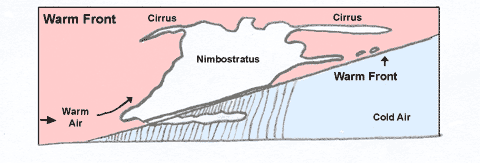Hauraki Gulf Weather
New Zealand is a country made up of many islands surrounded by sea that is subject to changes in the weather. It has four seasons and the weather follows reasonably predictable seasonal patterns.
Atmospheric circulation brings large masses of warm or cold air together. These can form warm or cold fronts with the associated rain and cloud formations.


The prevailing south westerly wind comes in over the cool Tasman Sea and meets the warmer Pacific Ocean air. Moist weather from the northwest occasionally brings a tropical cyclone to the north of the country. Winds from the south and southeast bring colder antarctic air.
Daily weather changes may be associated with wind strength and direction, temperature and cloud cover. Observation of these changes over time allows us to predict future weather patterns.
Weather features we can observe or feel include - clouds, wind direction and speed temperature, rain and humidity. There are instruments we can use to measure these (see table below):
|
Weather Instrument |
What it measures (units) |
|
|
Thermometer |
temperature (Celsius) |
 |
|
Hygrometer |
humidity |
|
|
Rain gauge |
rainfall (millimetres) |
 |
|
Weather vane |
wind direction |
 |
|
Anemometer |
wind speed (km/hr or knots) |
|
|
Barometer |
air pressure (hectopascals - hPa) |
 |